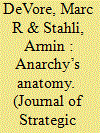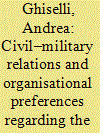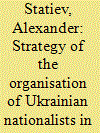| Srl | Item |
| 1 |
ID:
171209


|
|
|
|
|
| Summary/Abstract |
No issue deserves more scrutiny than the mechanisms whereby popular unrest unleashes civil wars. We argue that one institution – two-tiered security systems – is particularly pernicious in terms of the accompanying civil war risk. These systems’ defining characteristic is the juxtaposition of small communally stacked units that protect regimes from internal adversaries with larger regular armed forces that deter external opponents. These systems aggravate civil war risks because stacked security units lack the size to repress widespread dissent, but inhibit rapid regime change through coup d’état. Regular militaries, meanwhile, fracture when ordered to employ force against populations from which they were recruited.
|
|
|
|
|
|
|
|
|
|
|
|
|
|
|
|
| 2 |
ID:
171208


|
|
|
|
|
| Summary/Abstract |
Over a decade of security force assistance (SFA) initiatives to build an effective Somali National Army (SNA) failed because of the interrelated effects of political, contextual and operational challenges. The key political challenges were interest asymmetry between international actors and Somali elites, insufficient focus on institution-building and a lack of donor coordination. The principal contextual challenges in Somalia were the legacies of two decades of state collapse and the negative effects of clan dynamics. The main operational challenges were building an army while simultaneously fighting a war, the complexities of military integration, and the severe capability gaps afflicting the SNA.
|
|
|
|
|
|
|
|
|
|
|
|
|
|
|
|
| 3 |
ID:
171210


|
|
|
|
|
| Summary/Abstract |
This article analyses the positions of the Chinese civilian leaders and military elites on Military Operations Other Than War in order to shed light on their preferences about the use of the armed forces in foreign policy between the late 1990s and the early 2010s. Over time, a significant divergence developed between civilians and soldiers until 2011, when the Libyan crisis happened. The study also prompts important considerations about our understanding of civil–military relations in China and future role of the People’s Liberation Army as a tool of statecraft in foreign policy.
|
|
|
|
|
|
|
|
|
|
|
|
|
|
|
|
| 4 |
ID:
171207


|
|
|
|
|
| Summary/Abstract |
The conventional wisdom about the 1992 US intervention in Somalia is that it was a quintessentially humanitarian mission pushed by President George H. W. Bush. This article challenges that interpretation, drawing on newly declassified documents. The Somalia intervention, I argue, was largely a pragmatic response to concerns held by the US military. In late 1992, as the small UN mission in Somalia was collapsing, senior American generals worried about being drawn into the resulting vacuum. Hence they reluctantly recommended a robust US intervention, in the expectation that this would allow the UN to assemble a larger peacekeeping force that would take over within months. The intervention ultimately failed, but the military learned useful lessons from this experience on how to achieve smoother UN handoffs in the future and thus effectively shift longer-term stabilisation burdens to the international community.
|
|
|
|
|
|
|
|
|
|
|
|
|
|
|
|
| 5 |
ID:
171211


|
|
|
|
|
| Summary/Abstract |
The armed resistance offered by the Organization of Ukrainian Nationalists (OUN) to the Soviet state was the toughest internal political challenge that the Soviet regime faced from World War II to the 1980s. However, OUN’s grand strategy was based on self-delusion and was, therefore, always irrational. It resulted in misinterpretation of the sentiments of Ukrainians and the international situation, collaboration with Nazi Germany despite incompatible goals, counterproductive ethnic violence and sweeping terror against alleged Soviet collaborators. Local civilians rather than the representatives of the Soviet regime were OUN’s primary target; this alienated most residents of Western Ukraine.
|
|
|
|
|
|
|
|
|
|
|
|
|
|
|
|